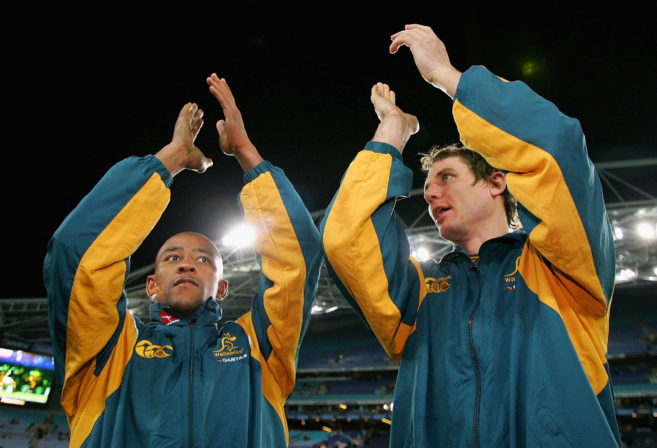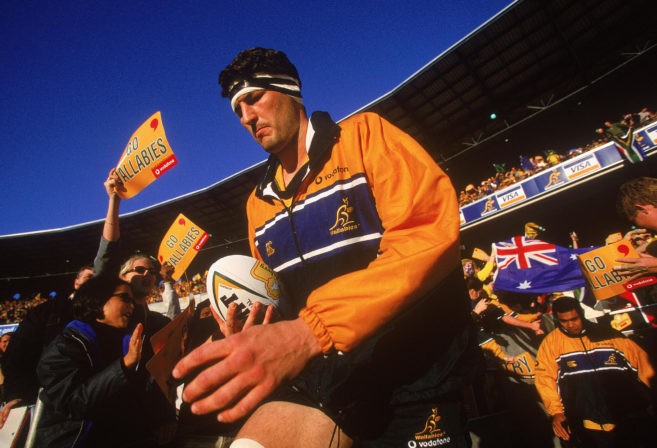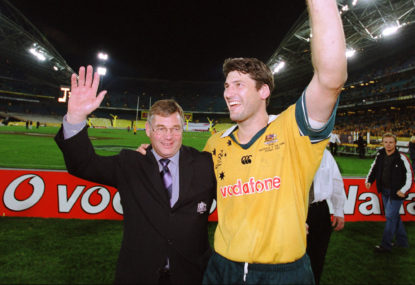Success in team sports is, funnily enough, all about teamwork. Individual talent is amplified in the presence of supporting colleagues.
With that focus, here are the top three greatest partnerships in Australian rugby history, guys who not only had a great understanding on the field, but off it as well.
3. Tim Horan and Jason Little: Best mates off the park, world-beaters on it
Tim Horan is widely regarded as one of the greatest centres to ever play the game, while many regard Jason Little as one of the most underrated. At their peak, they were perhaps the most celebrated centre pairing in world rugby.
First encountering each other as 13-year-olds in a Queensland junior representative rugby league side, Horan and Little instantly hit it off. They would later both represent Queensland Schoolboys in cricket, as well as playing alongside each other for the Australian Schoolboys rugby side.
Club rugby teammates in Brisbane and for the Queensland Reds, the Little-Horan double-act provided scything attack coupled with rock-solid defence, which was boosted by their seemingly telepathic ability to understand each other’s movements.
The pair’s partnership even extended as far as getting injured together, both suffering knee injuries in the same game in South Africa which required both of them to leave the stadium in wheelchairs, back to the team hotel where they were, of course, rooming together – incredibly in room 1213!
Lining up at 12 and 13 for the 1991 World Cup final, Horan and Little would celebrate global glory together again eight years later in 1999, with Horan many experts’ pick as the player of the tournament.
Little, never one to seek attention or recognition, regularly credits Horan with much of his own success, often citing the fact that while playing alongside Horan, the pair were regarded as the finest centre combination in the game, and when Little made way for Daniel Herbert later in his career, the Horan-Herbert combination quickly became known as one of the best pairings in the world.
After more than a decade of international rugby, their Test records were incredibly similar. Horan scored 30 tries in 80 matches for the Wallabies while Little crossed the line 21 times in 75 appearances.
The pair are part of an elite club of players to have won the Rugby World Cup twice and remain close decades after their first encounter, spending Christmas together along with their families.

Tim Horan playing against the Springboks, probably trying to find his mate Jason. (David Rogers/Allsport)
2. George Gregan and Stephen Larkham: The ice-cool combo from Canberra
A quality scrumhalf/fly-half combination is often the foundation for success in rugby, so when two of the greatest halves the game has ever seen run out alongside each other 79 times in Test matches, it’s no surprise that it coincided with the most decorated period in Australian rugby history.
George Gregan – Wallaby captain and one-time world record-holder for Test caps – and fellow Canberra local Stephen Larkham provided Wallabies fans with some of their most memorable moments, from that tackle by Gregan on All Blacks winger Jeff Wilson at the Sydney Football Stadium to Larkham’s 48-metre drop goal against the Springboks at Twickenham on the way to World Cup glory in Cardiff.
Australian rugby was blessed with talent during the Rod Macqueen era. They had a forward pack that blended the smarts of John Eales with the physicality of Owen Finnegan, and a backline that boasted generational talents like Matt Burke and Joe Roff in their primes.
But the conductors of the show were the halves pairing of Gregan and Larkham.
Gregan was a fierce competitor, clever in attack and tenacious in defence. He was never lost for words when the opportunity arose to give an opposing player some constructive feedback or a referee some helpful advice while waiting for a scrum to pack down.
Larkham, however, was the original ice-man. Seemingly unflappable, he rarely spoke and was never flustered, a quality which earned him the nickname ‘Bernie’ from his teammates in reference to the character from the film Weekend at Bernie’s.
His languid running style made Larkham even more enjoyable to watch, as his ability to send defenders the wrong way with a surprisingly effective step was matched only by his proclivity to create a hole in the defensive line before sending a teammate through it.
It is often a trait of the best players in any sport that they appear to have more time than the rest. In an era where the game of rugby was played at a faster pace than it is today, Gregan and Larkham seemed to forever be operating in slow motion.
Larkham’s ability to read a game has seen him move into coaching, previously taking the reins at the Brumbies before joining the current Wallabies coaching staff under Michael Cheika. Gregan has shown that his smarts also extended beyond the touchline, and now has a hand in successful hospitality and fitness equipment ventures.
World champions in Wallaby gold in 1999 and Super Rugby champions for their hometown Brumbies, the pair accumulated a combined 238 Test caps and 263 Super Rugby appearances. In 2007, the eastern stand at Canberra Stadium was renamed in the pair’s honour in recognition of their contribution to the game.

1. John Eales and Rod Macqueen: Master and commander
Perhaps not the most instantly identifiable double-act, but without doubt the most successful coach-captain partnership Australian rugby has ever seen.
John Eales assumed the Wallaby captaincy from Rod McCall in 1996 already a Rugby World Cup winner, but it was his partnership with Macqueen, who was appointed national coach in 1997, that took the Wallabies to new heights.
During the period of 1997 through 2001, the Wallabies won every piece of silverware that was available to them. An unprecedented period of dominance in the Bledisloe Cup was just the beginning as Australia won the 1999 World Cup as well as a first Tri-Nations win in 2000, a feat they repeated a year later after they had also secured a first-ever series win over the British and Irish Lions.
Coming into the job as Wallaby coach, Macqueen had experienced success with New South Wales and had played a key role in establishing the success that the ACT Brumbies were about to enjoy. Regarded as an excellent motivator who possessed the ability to get the best out of groups of individuals in order to unlock their collective potential, Macqueen oversaw perhaps the greatest generation of Wallaby talent.
But it was not love at first sight. Macqueen took the Wallaby job on the back of a 61-22 loss to the Springboks that lead to former coach Greg Smith’s departure, and at first Macqueen aired concerns about John Eales’ role as skipper of the side. He even entertained the thought of ditching Eales in favour of George Gregan, who he saw as a better fit for his style of coaching.

However, after a short discussion with Eales, Macqueen stuck by the incumbent and it was to become a match made in heaven. In Macqueen’s search for perfection, his on-field leader was to become known colloquially as ‘Nobody’ – because ‘nobody’s perfect’.
Eales’ calm demeanour on and off the park belied his rugby abilities. 86 Test matches and 173 points (making him the highest ever point-scoring forward) is a remarkable enough record on its own, but Eales’ game was always about so much more than the numbers. His ability to stay ultra-cool in even the most intense of atmospheres set the tone for the whole team and was almost an extension of Macqueen’s arm down from the coach’s box.
Ask any Wallabies fan to recall their most fond memories and a common theme emerges. The 1999 World Cup win, Eales’ penalty goal in Wellington to win the Bledisloe Cup, Stirling Mortlock’s long-range penalty to win the Tri-Nations in Durban, Toutai Kefu’s Mr Gadget-like extended arm to retain the Bledisloe Cup in Sydney, Justin Harrison’s lineout steal at the death of the third Lions Test in 2001… all of those moments came during the Eales-Macqueen leadership era.
A truly golden age for the men in gold and the reason why John Eales and Rod Macqueen make up the greatest partnership in Australian rugby history.
Dove Men+Care believes real winners care. It takes skill to win but care to be a winner. Find out more here.

































































































